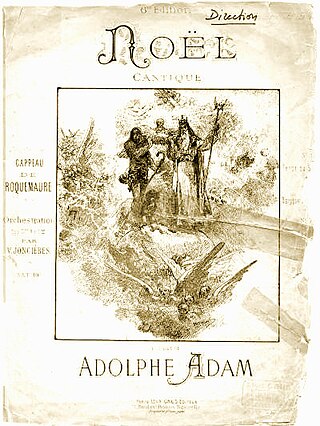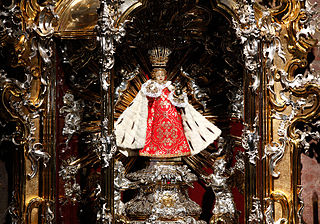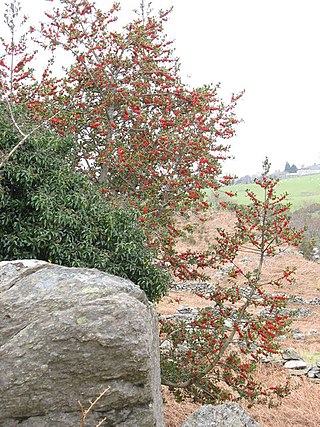
Christ, used by Christians as both a name and a title, unambiguously refers to Jesus. It is also used as a title, in the reciprocal usage "Christ Jesus", meaning "the Messiah Jesus" or "Jesus the Anointed", and independently as "the Christ". The Pauline epistles, the earliest texts of the New Testament, often call Jesus "Christ Jesus" or just "Christ".

A Christmas carol is a carol (a song or hymn) on the theme of Christmas, traditionally sung at Christmas itself or during the surrounding Christmas and holiday season. The term noel has sometimes been used, especially for carols of French origin. Christmas carols may be regarded as a subset of the broader category of Christmas music.
"Joy to the World" is an English hymn and Christmas carol. It was written in 1719 by the English minister and hymnist Isaac Watts. It is usually sung to the American composer Lowell Mason's 1848 arrangement of a tune attributed to George Frideric Handel. The hymn's lyrics are a Christian interpretation of Psalm 98 and Genesis 3.

"O Holy Night" is a sacred song about the night of the birth of Jesus Christ, described in the first verse as "the dear Saviour", and frequently performed as a Christmas carol. Based on the French-language poem Minuit, chrétiens, written in 1843 by poet Placide Cappeau, it was set to music by composer Adolphe Adam. The English version, with small changes to the initial melody, is by John Sullivan Dwight.

"O Tannenbaum", known in English as "O Christmas Tree", is a German Christmas song. Based on a traditional folk song that was unrelated to the holiday, it became associated with the traditional Christmas tree.

The Christ Child—also known as Baby Jesus, Infant Jesus, Child Jesus, Divine Child, Divine Infant and the Holy Child—refers to Jesus Christ during his early years. The term refers to a period of Jesus' life, described in the canonical Gospels, encompassing his nativity in Bethlehem, the visit of the Magi, and his presentation at the Temple in Jerusalem. It also includes his childhood, culminating in the event where his parents find him in the Temple at age 12, after which the Gospels remain silent about his life until the start of his ministry.

The Messiah - Salabue Stradivarius of 1716 is a violin made by the Italian luthier Antonio Stradivari of Cremona. It is considered to be the only Stradivarius in existence in as "new" state. The neck has been lengthened and at minimum the bass bar, bridge, tailpiece, and pegs have been replaced. It is in the collection of the Ashmolean Museum in Oxford, England.

Marian hymns are Christian songs focused on Mary, mother of Jesus. They are used in devotional and liturgical services, particularly by the Roman Catholic, Eastern Orthodox, Oriental Orthodox, Anglican, and Lutheran churches.

"The Holly and the Ivy" is a traditional British folk Christmas carol, listed as number 514 in the Roud Folk Song Index. The song can be traced only as far as the early nineteenth century, but the lyrics reflect an association between holly and Christmas dating at least as far as medieval times. The lyrics and melody varied significantly in traditional communities, but the song has since become standardised. The version which is now popular was collected in 1909 by the English folk song collector Cecil Sharp in the market town of Chipping Campden in Gloucestershire, England, from a woman named Mary Clayton.
"God Rest Ye Merry, Gentlemen", also known as "God Rest You Merry, Gentlemen", is an English traditional Christmas carol. It is in the Roxburghe Collection, and is listed as no. 394 in the Roud Folk Song Index. It is also known as "Tidings of Comfort and Joy," and by other variant incipits.
David John Briggs is an English organist and composer.
"Bring a Torch, Jeanette, Isabella" is a Christmas carol which originated from the Provence region of France in the 17th century.
The birth of Jesus has been depicted since early Christianity, and continues to be interpreted in modern artistic forms. Some of the artforms that have described Jesus' nativity include drama and music. Featured characters usually include Jesus, Mary, and Joseph.

Star singers, also known as Epiphany singers, or Star boys' singing procession (England), are children and young people walking from house to house with a star on a rod and often wearing crowns and dressed in clothes to resemble the Three Magi. The singing processions have their roots in an old medieval ecclesiastical play, centred on the Biblical Magi of the Christmas story in the Gospel of Matthew, appropriate to Epiphany. It is observed usually during the period between 27 December and 6 January.
The abbé Simon-Joseph Pellegrin (1663 – 5 September 1745) was a French poet and playwright, a librettist who collaborated with Jean-Philippe Rameau and other composers.
"Une jeune Pucelle" is a French folk song from 1557, which has a melody that is based loosely on an older French song entitled "Une jeune Fillette".
"Il est né, le divin Enfant" is a traditional French Christmas carol.

Léonce Marie-Joseph, Comte de Saint-Martin-de-Paylha, shortened to and more well known by Léonce de Saint-Martin, was a French organist and composer.
Advent songs are songs and hymns intended for Advent, the four weeks of preparation for Christmas. Topics of the time of expectation are the hope for a Messiah, prophecies, and the symbolism of light, among others. Several of the songs are part of hymnals such as the German Catholic Gotteslob (GL) and the Protestant Evangelisches Gesangbuch (EG).

Messe de minuit pour Noël, H.9, is a mass for four voices and orchestra by Marc-Antoine Charpentier, written in 1694 based on the melodies of ten French Christmas carols. Charpentier called for eight soloists, a duo of two sopranos and two trios of alto, tenor and bass, but it can be performed by five soloists. Choir and orchestra are in four parts, scored for flutes, strings, organ and basso continuo. The mass is regarded as unique in both the composer's work and in the genre. While in Charpentier's time, the mass was performed by all-male choirs, it has later been performed and recorded also by mixed choirs with modern instruments.











